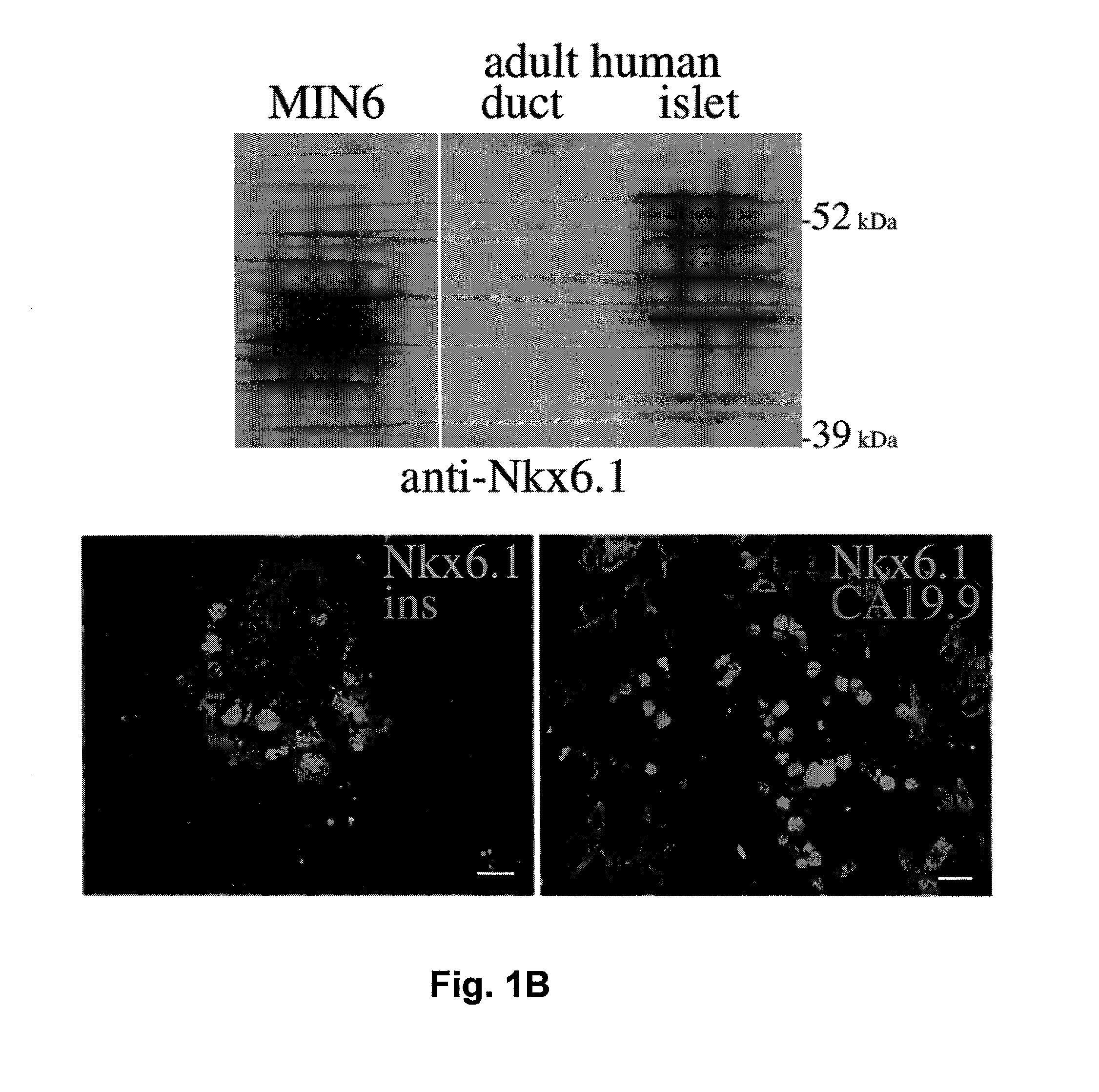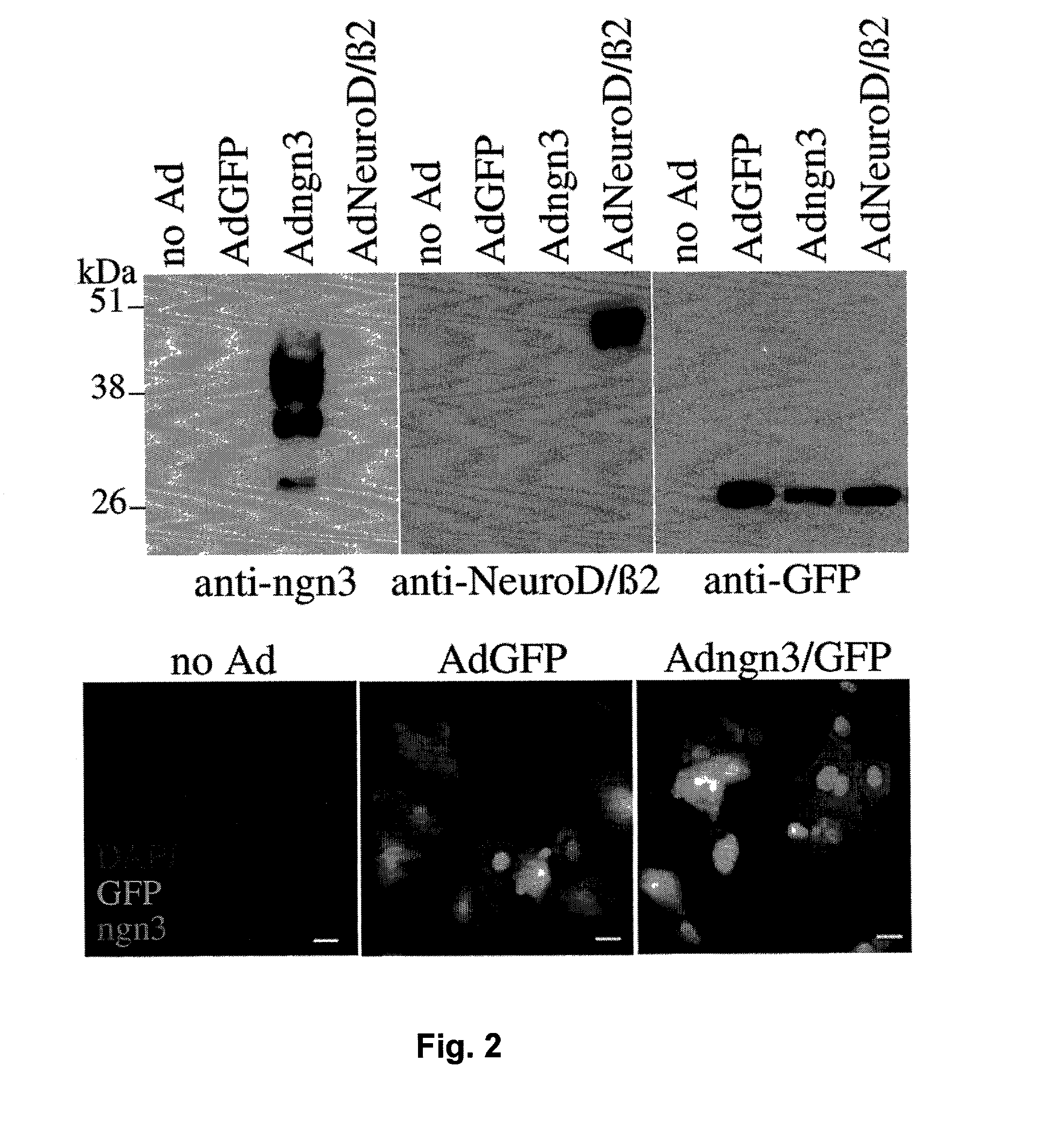Methods for generating insulin-secreting cells suitable for transplantation
a technology of generating cells and transplantation, applied in the direction of embryonic cells, pancreatic cells, genetically modified cells, etc., can solve the problem of limited cell type generation of somatic tissu
- Summary
- Abstract
- Description
- Claims
- Application Information
AI Technical Summary
Benefits of technology
Problems solved by technology
Method used
Image
Examples
example 1
Animals and Pancreas Microdissection
[0142] Time-mated pregnant mice (CD1) and rats (Wistar-Furth) were obtained from Bomholtg.ang.ard Breeding Centre (Ry, Denmark). Embryos (one litter at a time) were liberated in chilled Hanks' balanced salt solution; pancreases were collected by microdissection and were transferred directly to RNAzol-B (Biotecx, Houston, Tex.) for reverse transcriptase-polymerase chain reaction (RT-PCR) analyses. Material used for histological analysis was fixed overnight in 4% paraformaldehyde (PFA) before paraffin-embedding. Sections of 4 .mu.m were cut and stored at room temperature until use. Material for whole-mount in situ hybridizations was fixed overnight in 4% PFA in Ca.sup.2+ and Mg.sup.2+ free phosphate-buffered saline (PBS) and 2 mmol / l EGTA. The tissues were dehydrated in methanol and stored at -20.degree. C. until use. For RT-PCR, rat pancreatic tissue originating from the dorsal bud was isolated before fusion; at later stages, tissue from the promin...
example 2
Antisera and in situ Hybridization Probes
[0143] Guinea pig anti-insulin was obtained from Nordisk Gentofte A / S (Gentofte, Denmark). Mouse monoclonal antiglucagon-Glu001 was obtained from Novo Nordisk A / S (Bagsv.ae butted.rd, Denmark). Rabbit anti-PDX1-1856 and rabbit anti-Nkx6.1-174 have been described previously (Jensen et al. (1996) J. Biol. Chem. 271:18749-18758). Rabbit anti-IDX1-253 (Stoffers et al. (1998) J. Clin. Invest. 102:232-241) was a gift from J. Habener. Rabbit anti-BRN4 was a kind gift from M. Rosenfeld. Rabbit anti-PAX6-Bg11 (Turque et a. (1994) Mol. Endocrinol. 8:929-938) was a gift from S. Saule. Rabbit anti-ISL1 (Thor et al. (1991) Neuron 7:881-889) was a gift from H. Edlund. Mouse monoclonal anti-ISL1, developed by T. Jessell, was obtained from the Developmental Studies Hybridoma Bank, which is under the auspices of the National Institute of Child Health and Human Development and maintained by the Department of Biological Sciences at the University of Iowa (Iowa ...
example 3
Immunohistochemistry and in situ Hybridization
[0144] Imunohistochemistry was performed as described in Blume et al. (1992) Mol. Endocrinol. 6:299-307. Briefly, sections were dewaxed in xylene and rehydrated through a descending ethanol series. Antigen retrieval was accomplished through microwave treatment (two times for 5 min at 600 W in 0.01 mol / l citrate buffer, pH 6.0) followed by three washes in PBS. Nonspecific binding was blocked with 10% donkey nonimmuneserum. For double immunofluorescence, sections were incubated with primary antibodies overnight. Secondary antibodies (fluorescein isothiocyanate-, Cy-2-, and Texas-Red-conjugated) were obtained from Jackson ImmunoResearch (West Grove, Pa.). In situ hybridization on paraffin sections was performed by first dewaxing and rehydrating paraffin sections through an ethanol series. Three washes in diethyl pyrocarbonate (DEPC)-treated PBS were followed by a 5-10 min treatment with proteinase K (10 .mu.g / ml). Slides were fixed in fresh...
PUM
| Property | Measurement | Unit |
|---|---|---|
| pH | aaaaa | aaaaa |
| volume | aaaaa | aaaaa |
| temperature | aaaaa | aaaaa |
Abstract
Description
Claims
Application Information
 Login to View More
Login to View More - R&D
- Intellectual Property
- Life Sciences
- Materials
- Tech Scout
- Unparalleled Data Quality
- Higher Quality Content
- 60% Fewer Hallucinations
Browse by: Latest US Patents, China's latest patents, Technical Efficacy Thesaurus, Application Domain, Technology Topic, Popular Technical Reports.
© 2025 PatSnap. All rights reserved.Legal|Privacy policy|Modern Slavery Act Transparency Statement|Sitemap|About US| Contact US: help@patsnap.com



